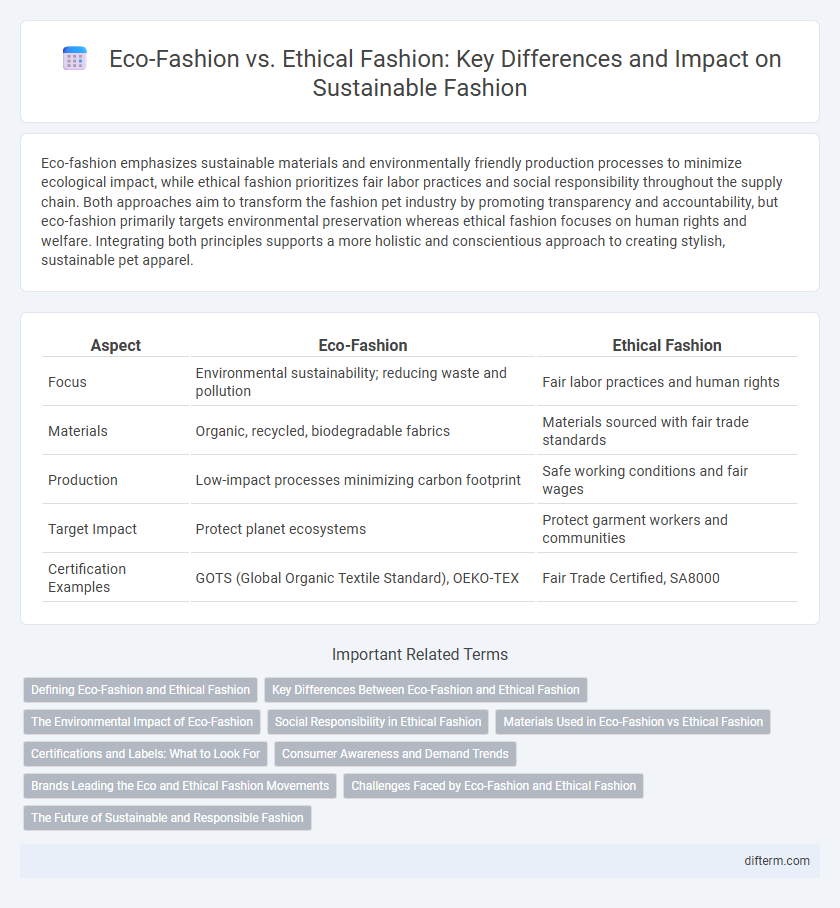Eco-fashion emphasizes sustainable materials and environmentally friendly production processes to minimize ecological impact, while ethical fashion prioritizes fair labor practices and social responsibility throughout the supply chain. Both approaches aim to transform the fashion pet industry by promoting transparency and accountability, but eco-fashion primarily targets environmental preservation whereas ethical fashion focuses on human rights and welfare. Integrating both principles supports a more holistic and conscientious approach to creating stylish, sustainable pet apparel.
Table of Comparison
| Aspect | Eco-Fashion | Ethical Fashion |
|---|---|---|
| Focus | Environmental sustainability; reducing waste and pollution | Fair labor practices and human rights |
| Materials | Organic, recycled, biodegradable fabrics | Materials sourced with fair trade standards |
| Production | Low-impact processes minimizing carbon footprint | Safe working conditions and fair wages |
| Target Impact | Protect planet ecosystems | Protect garment workers and communities |
| Certification Examples | GOTS (Global Organic Textile Standard), OEKO-TEX | Fair Trade Certified, SA8000 |
Defining Eco-Fashion and Ethical Fashion
Eco-fashion prioritizes sustainable materials and manufacturing processes that minimize environmental impact, such as organic cotton, recycled fabrics, and low-water dyeing techniques. Ethical fashion emphasizes fair labor practices, ensuring safe working conditions and fair wages for workers throughout the supply chain. Both movements aim to transform the fashion industry by promoting transparency, responsibility, and long-term sustainability.
Key Differences Between Eco-Fashion and Ethical Fashion
Eco-fashion emphasizes the use of sustainable materials and environmentally friendly production processes to minimize pollution and resource consumption. Ethical fashion prioritizes fair labor practices, ensuring safe working conditions, fair wages, and respect for human rights throughout the supply chain. While both aim to promote responsible industry standards, eco-fashion focuses on environmental impact, and ethical fashion centers on social and labor ethics.
The Environmental Impact of Eco-Fashion
Eco-fashion significantly reduces environmental impact through the use of sustainable materials like organic cotton, recycled fabrics, and low-impact dyes that minimize pollution and resource depletion. It emphasizes energy-efficient production processes and waste reduction, contributing to lower carbon emissions and water usage compared to conventional fashion. These practices help protect ecosystems, promote biodiversity, and support climate change mitigation efforts within the fashion industry.
Social Responsibility in Ethical Fashion
Ethical fashion emphasizes social responsibility by ensuring fair wages, safe working conditions, and the empowerment of marginalized communities throughout the supply chain. It advocates transparency and accountability from brands to promote workers' rights and combat exploitation. This focus on human welfare differentiates ethical fashion from eco-fashion, which primarily centers on environmental sustainability.
Materials Used in Eco-Fashion vs Ethical Fashion
Eco-fashion primarily emphasizes sustainable materials such as organic cotton, hemp, and recycled fibers to minimize environmental impact through resource conservation and reduced pollution. Ethical fashion prioritizes fair labor practices and often incorporates materials sourced through transparent supply chains ensuring worker welfare alongside environmental considerations. Both approaches intersect in promoting responsible material choices, but eco-fashion centers on ecological sustainability, while ethical fashion balances material use with social justice.
Certifications and Labels: What to Look For
Key certifications to identify eco-fashion include GOTS (Global Organic Textile Standard) and OEKO-TEX, which ensure organic materials and non-toxic fabrics. For ethical fashion, look for Fair Trade Certified and SA8000 labels, indicating fair labor practices and safe working conditions. These certifications provide transparency and accountability for sustainable and socially responsible fashion choices.
Consumer Awareness and Demand Trends
Consumer awareness of eco-fashion, which emphasizes sustainable materials and low environmental impact, has surged alongside growing concern for climate change. Ethical fashion, centered on fair labor practices and social responsibility, increasingly influences purchasing decisions as shoppers seek transparency and brand accountability. Demand trends reveal a significant shift toward brands that integrate both ecological sustainability and ethical standards, reflecting a holistic approach to conscious consumerism.
Brands Leading the Eco and Ethical Fashion Movements
Patagonia and Stella McCartney are pioneering brands in eco-fashion, utilizing sustainable materials and innovative recycling techniques to minimize environmental impact. Eileen Fisher and Everlane emphasize ethical fashion by ensuring fair labor practices and transparency throughout their supply chains. These brands set industry standards by integrating environmental responsibility with social equity, driving the shift toward more sustainable and ethical consumer choices.
Challenges Faced by Eco-Fashion and Ethical Fashion
Eco-fashion faces challenges including sourcing sustainable materials that meet quality and aesthetic standards while minimizing environmental impact, alongside higher production costs that limit scalability. Ethical fashion struggles with ensuring fair labor practices throughout complex supply chains, addressing wage disparities, and combating exploitative working conditions without significantly increasing product prices. Both sectors encounter difficulties in educating consumers about the true value and impact of sustainable and ethical choices amid widespread greenwashing and fast fashion competition.
The Future of Sustainable and Responsible Fashion
Eco-fashion emphasizes environmentally-friendly materials and processes, reducing waste and carbon footprint, while ethical fashion prioritizes fair labor practices and social responsibility across the supply chain. The future of sustainable and responsible fashion integrates both approaches, promoting circular economy models and transparent sourcing to meet consumer demand for accountability. Advances in biodegradable textiles, blockchain for traceability, and inclusive labor standards will drive innovation and reshape industry norms.
Eco-fashion vs ethical fashion Infographic

 difterm.com
difterm.com